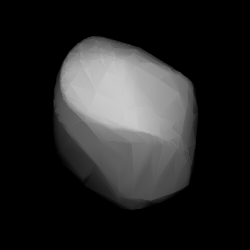Astronomy:771 Libera
 Modelled shape of Libera from its lightcurve | |
| Discovery [1] | |
|---|---|
| Discovered by | J. Rheden |
| Discovery site | Vienna Observatory |
| Discovery date | 21 November 1913 |
| Designations | |
| (771) Libera | |
| Pronunciation | Classically /ˈlɪbərə/[4] |
| Named after | friend of discoverer[2] |
| 1913 TO · 1958 HA | |
| Minor planet category | main-belt · (middle) [3] |
| Orbital characteristics [1] | |
| Epoch 31 July 2016 (JD 2457600.5) | |
| Uncertainty parameter 0 | |
| Observation arc | 101.75 yr (37166 d) |
| |{{{apsis}}}|helion}} | 3.3092 astronomical unit|AU (495.05 Gm) |
| |{{{apsis}}}|helion}} | 1.9937 AU (298.25 Gm) |
| 2.6514 AU (396.64 Gm) | |
| Eccentricity | 0.24808 |
| Orbital period | 4.32 yr (1576.9 d) |
| Mean anomaly | 268.14° |
| Mean motion | 0° 13m 41.844s / day |
| Inclination | 14.936° |
| Longitude of ascending node | 218.19° |
| 227.36° | |
| Earth MOID | 1.03684 AU (155.109 Gm) |
| Jupiter MOID | 2.11238 AU (316.008 Gm) |
| TJupiter | 3.299 |
| Physical characteristics | |
| Dimensions | 29.38±1.1 km (IRAS:6)[1][5] 28.91±0.72 km[6] 29.000±1.403 km[7] 29.33 km (derived)[3] |
| Mean radius | 14.69±0.55 km |
| Rotation period | 5.892±0.002 h[8] 5.92 h[9] 5.886±0.001 h[10] 5.89±0.05 h[10] 5.890±0.001 h[11] 5.892 h (0.2455 d)[1] |
| Geometric albedo | 0.1303±0.010 (IRAS:6)[1] [5] 0.141±0.008[6] 0.1299±0.0158[7] 0.1226 (SIMPS)[3] |
| B–V = 0.687 U–B = 0.300 X (Tholen), X (SMASS), X [3] | |
| Absolute magnitude (H) | 10.49[1] |
771 Libera, provisional designation 1913 TO, is a metallic asteroid from the middle region of the asteroid belt, about 29 kilometers in diameter. It was discovered by Austrian astronomer Joseph Rheden at the Vienna Observatory in Austria, on 21 November 1913.[12]
Description

The metallic X-type asteroid orbits the Sun at a distance of 2.0–3.3 AU once every 4 years and 4 months (1,576 days). Its orbit shows an eccentricity of 0.25 and is tilted by 15 degrees to the plane of the ecliptic. A photometric observation of the asteroid's light-curve performed at the Palmer Divide Observatory during 1999 rendered a rotation period of 5.892±0.002 hours with a brightness variation of 0.57 magnitude.[8] The result concurs with several previous observations, including a photometric analysis conducted over a twelve-year interval.[9][10][11]
According to the surveys carried out by the Infrared Astronomical Satellite, IRAS, the Japanese Akari satellite, and the U.S. Wide-field Infrared Survey Explorer with its subsequent NEOWISE mission, the asteroid's surface has an albedo of 0.13 and 0.14, respectively, while the Collaborative Asteroid Lightcurve Link publishes a slightly lower figure of 0.12 from an alternative result of the Supplemental IRAS Minor Planet Survey.[3]
The minor planet was named by Mrs. Hedwig Rheden in honor of a friend of the discoverer.[2]
References
- ↑ 1.0 1.1 1.2 1.3 1.4 1.5 "JPL Small-Body Database Browser: 771 Libera (1913 TO)". Jet Propulsion Laboratory. https://ssd.jpl.nasa.gov/sbdb.cgi?sstr=2000771.
- ↑ 2.0 2.1 Schmadel, Lutz D. (2003). "(771) Libera". Dictionary of Minor Planet Names – (771) Libera. Springer Berlin Heidelberg. p. 73. doi:10.1007/978-3-540-29925-7_772. ISBN 978-3-540-29925-7.
- ↑ 3.0 3.1 3.2 3.3 3.4 "LCDB Data for (771) Libera". Asteroid Lightcurve Database (LCDB). http://www.minorplanet.info/PHP/generateOneAsteroidInfo.php?AstInfo=771%7CLibera.
- ↑ Noah Webster (1884) A Practical Dictionary of the English Language
- ↑ 5.0 5.1 Tedesco, E. F.; Noah, P. V.; Noah, M.; Price, S. D. (October 2004). "IRAS Minor Planet Survey V6.0". NASA Planetary Data System 12: IRAS-A-FPA-3-RDR-IMPS-V6.0. Bibcode: 2004PDSS...12.....T. https://sbnarchive.psi.edu/pds3/iras/IRAS_A_FPA_3_RDR_IMPS_V6_0/data/diamalb.tab. Retrieved 22 October 2019.
- ↑ 6.0 6.1 Usui, Fumihiko; Kuroda, Daisuke; Müller, Thomas G.; Hasegawa, Sunao; Ishiguro, Masateru; Ootsubo, Takafumi et al. (October 2011). "Asteroid Catalog Using Akari: AKARI/IRC Mid-Infrared Asteroid Survey". Publications of the Astronomical Society of Japan 63 (5): 1117–1138. doi:10.1093/pasj/63.5.1117. Bibcode: 2011PASJ...63.1117U. (online, AcuA catalog p. 153)
- ↑ 7.0 7.1 Mainzer, A.; Grav, T.; Masiero, J.; Hand, E.; Bauer, J.; Tholen, D. et al. (November 2011). "NEOWISE Studies of Spectrophotometrically Classified Asteroids: Preliminary Results". The Astrophysical Journal 741 (2): 25. doi:10.1088/0004-637X/741/2/90. Bibcode: 2011ApJ...741...90M. http://adsabs.harvard.edu/cgi-bin/bib_query?bibcode=2011ApJ...741...90M. Retrieved 4 January 2016.
- ↑ 8.0 8.1 Warner, B. (March 2000). "Asteroid Photometry at the Palmer Divide Observatory". The Minor Planet Bulletin 27: 4–6. Bibcode: 2000MPBu...27....4W. http://adsabs.harvard.edu/cgi-bin/bib_query?bibcode=2000MPBu...27....4W. Retrieved 4 January 2016.
- ↑ 9.0 9.1 Binzel, R. P. (October 1987). "A photoelectric survey of 130 asteroids". Icarus 72 (1): 135–208. doi:10.1016/0019-1035(87)90125-4. ISSN 0019-1035. Bibcode: 1987Icar...72..135B. http://adsabs.harvard.edu/cgi-bin/bib_query?bibcode=1987Icar...72..135B. Retrieved 4 January 2016.
- ↑ 10.0 10.1 10.2 Behrend, Raoul. "Asteroids and comets rotation curves – (771) Libera". Geneva Observatory. http://obswww.unige.ch/~behrend/page3cou.html#000771.
- ↑ 11.0 11.1 Marciniak, A.; Michalowski, T.; Hirsch, R.; Behrend, R.; Bernasconi, L.; Descamps, P. et al. (December 2009). "Photometry and models of selected main belt asteroids. VII. 350 Ornamenta, 771 Libera, and 984 Gretia". Astronomy and Astrophysics 508 (3): 1503–1507. doi:10.1051/0004-6361/200912741. Bibcode: 2009A&A...508.1503M. http://adsabs.harvard.edu/cgi-bin/bib_query?bibcode=2009A&A...508.1503M. Retrieved 4 January 2016.
- ↑ "771 Libera (1913 TO)". Minor Planet Center. https://www.minorplanetcenter.net/db_search/show_object?object_id=771.
External links
- Lightcurve plot of 771 Libera, Palmer Divide Observatory, B. D. Warner (1999)
- Asteroid Lightcurve Database (LCDB), query form (info )
- Dictionary of Minor Planet Names, Google books
- Asteroids and comets rotation curves, CdR – Observatoire de Genève, Raoul Behrend
- Discovery Circumstances: Numbered Minor Planets (1)-(5000) – Minor Planet Center
- 771 Libera at AstDyS-2, Asteroids—Dynamic Site
- 771 Libera at the JPL Small-Body Database
 |

